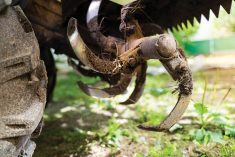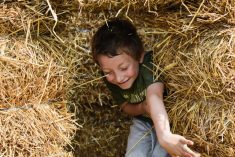Winter in Canada comes with all sorts of challenges — freezing temperatures, blizzards, poor visibility, ice-covered equipment and the threat of temperature-related injuries like frostbite. However, farm work does not take a break because of cold weather.
A healthy human body temperature is 37 C. A change of body temperature exceeding 1 C can be an indication of illness or environmental conditions beyond the body’s ability to cope. Understanding how to stay warm, knowing what the signs of cold-related health injuries are and how to respond to these injuries is important in protecting the health and welfare of everyone who works on your farm. Here are some tips for farming in wintry weather.
- Pay attention to the weather forecast. Sleet, snow or cold — knowing what to expect is the best way to prepare and plan for farm tasks and what gear is required to make it through the day.
- Dress for the conditions, including the following:
– Wear layers of loose-fitting clothing (but be mindful of loose clothing around moving equipment parts)
– Stay dry with water-resistant clothing.
– Wear windproof materials such as an outer shell.
– Wear clothing with proper ventilation.
– Keep a spare set of clothes on hand.
– Keep your head covered whenever possible.
– When head protection is necessary, make sure it is equipped with an insulated liner.
– Protect your feet with insulated socks and wear two pairs when possible.
– Protect your hands with insulated gloves.
- Take frequent breaks. Having a designated warm-up area is important when working in wet and cold conditions. This can be as simple as heading into the house or workshop or enjoying a few minutes in a toasty truck.
- Enjoy good nutrition. Getting enough good- quality food and water is important in all weather conditions.
- Be wise. In cases of extreme cold, getting a task accomplished might take more time or even a bit of creativity. Taking time to be thoughtful and creative about cold weather working could save fingers, toes and even a life. This could mean anything from delegating tasks to warmer days to making a policy that 10 minutes of work equals five minutes of break during extreme weather. Whatever you decide, make sure it protects your farm’s biggest assets — the people.
- Know the symptoms of hypothermia and frostbite. Watch out for symptoms like nausea, fatigue, dizziness, irritability or euphoria. You may also experience pain in your extremities (hands, feet, ears, etc.) and severe shivering.
- In cases of frostbite, the skin may become white. In the worst cases, the skin will blister but will not be painful. If someone shows signs of frostbite:
– Move to a warm area.
– Warm up the area with blankets, clothing and/or warm water (not hot).
– Do not rub the area or apply dry heat (e.g. hot water bottles or electric blankets) as these could cause skin tissue damage.
– Seek medical attention as soon as possible. - If someone shows signs of hypothermia:
– Seek medical attention and transport the victim to a medical care facility as soon as possible.
– If possible, move the victim to a warm area.
– Remove wet clothing and place the victim in blankets to gradually raise body temperature. Body-to-body contact can help warm the victim’s temperature slowly. Be sure to cover the person’s head.
– Give warm, sweet (caffeine-free, non-alcoholic) drinks unless the victim is rapidly losing consciousness or is unconscious or convulsing.
– Do not allow the victim to drink alcohol or smoke.
Winter weather can cause woes, but being prepared, dressing for the elements and being wise can keep everyone warm and safe this season. For more information about farm safety visit casa-acsa.ca.















